Students need only 3-feet of space in the classroom with masks, CDC says
CDC cites new research showing less than 6-feet is already working in schools.
Citing the "preponderance of the available evidence from U.S. schools," the Centers for Disease Control and Prevention announced Friday that 3-feet of distance among students is sufficient in the classroom so long as masks and other mitigation steps are taken to prevent the spread of COVID-19.
By easing spacing requirements, the new guidance is likely to make it significantly easier for many of the nation’s estimated 57 million K-12 students to return to the classroom in-person full-time.
It also makes it easier for President Joe Biden to make good on his promise of reopening most schools five days a week.
"The goal really is to reopen schools as quickly and safely as possible," Education Secretary Miguel Cardona said Thursday at a virtual forum sponsored by the CAA Foundation.
"Yes, I anticipate schools will be open in the fall, but I want them open in the spring. We can do it," Cardona added.
The CDC’s earlier suggestion that schools strictly enforce 6-feet of distancing in areas with high rates of COVID-19 meant that much of the country would have to go virtual or hybrid until case levels dropped -- or ignore CDC recommendations -- because of space limitations.

The new guidelines still encourage 6-feet of distancing around teachers and among children who are eating without a mask on, exercising, singing or shouting.
"These updated recommendations provide the evidence-based roadmap to help schools reopen safely, and remain open, for in-person instruction," CDC Director Rochelle Walensky said in a statement.
The decision prompted swift pushback from teachers unions, which said the research didn't look at underfunded urban schools and ignored the risks of aerosol exposure. Union leaders met Thursday at the White House with Vice President Kamala Harris.
Randi Weingarten, head of the American Federation of Teachers, says she’s urging the CDC to expand its research to urban schools.
"Kids need to be in school, and the AFT has advocated consistently for safely reopening in-person learning since last April, but we are concerned this change has been driven by a lack of physical space rather than the hard science on aerosol exposure and transmission,” she wrote in a statement.
Likewise, Becky Pringle, head of the National Education Association said "we are concerned that the CDC has changed one of the basic rules for how to ensure school safety without demonstrating certainty that the change is justified by the science and can be implemented in a manner that does not detract from the larger long-term needs of students."
When pressed by ABC News on the criticism by the unions, Walensky insisted the research pulled from “many different school settings." The key was being "100% masked," she said.
“We have done the science, and we've seen the science to ensure that this is safe for those schools," Walensky told reporters at a White House press briefing announcing the change.
In justifying its decision, the agency pointed to new studies in Missouri, Florida and Utah that found mask-wearing students inside a classroom weren't the source of outbreaks. The CDC though stuck with its assertion that community levels of viral transmission are still a factor in whether schools can keep COVID-19 out of the classrooms.
The move aligns the CDC with spacing recommendations by the World Health Organization and American Academy of Pediatrics.
"In summary, the preponderance of the available evidence from U.S. schools indicates that even when students were placed less than 6 feet apart in classrooms, there was limited SARS-CoV-2 transmission when other layered prevention strategies were consistently maintained," the CDC noted in a scientific brief citing research internationally and within the U.S.
In a Senate hearing on Thursday, it was clear the CDC is facing significant pressure from lawmakers. In her testimony, Walensky acknowledged the CDC’s earlier suggestion of enforcing 6-feet in schools created an outsized burden for crowded school districts and that many schools ignoring the recommendation were operating without significant problems.

"Indeed, because 6 feet has been such a challenge, science has leaned in," Walensky told a Senate committee, noting the new research underway.
Sen. Susan Collins, Republican of Maine, bluntly responded: "You need to do it now."
The earlier CDC plan suggested loosening that 6-feet restriction only when community transmission levels were extremely low.
Now, the guidance says 3-feet of distancing can be deployed in most cases, although there are exceptions. Teachers and other adult staff should keep 6-feet of distance between each other and with students, according to the guidance.
Students should be kept 6-feet apart any time masks can’t be worn, such as eating, and in common areas like school lobbies. The guidance also recommends 6-feet of distancing when students are exerting themselves such as singing, practicing band instruments, playing sports or exercising at school.
The guidelines also make a distinction for older kids and teens, who are more likely to spread infection than elementary-aged children.
If a community’s COVID rates is at the highest levels – known as the “red zone” -- middle school and high school students should be put into small groups known as “cohorting,” according to the CDC. Otherwise, the school should enforce the 6-feet rule.
The CDC’s updated guidance does not change its recommendations that teacher vaccinations are not necessary to reopen safely, although the CDC says education staff should be prioritized.
ABC News' Cheyenne Haslett, Sophie Tatum and Matthew Vann contributed to this report.




